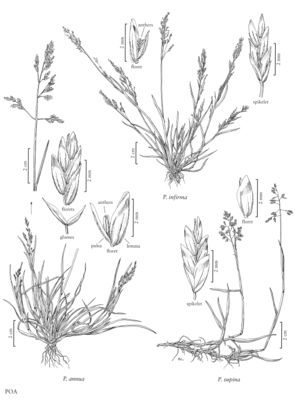Difference between revisions of "Poa infirma"
FNA>Volume Importer |
imported>Volume Importer |
||
| Line 4: | Line 4: | ||
|publications= | |publications= | ||
|common_names=Weak bluegrass | |common_names=Weak bluegrass | ||
| + | |special_status={{Treatment/ID/Special_status | ||
| + | |code=I | ||
| + | |label=Introduced | ||
| + | }} | ||
|basionyms= | |basionyms= | ||
|synonyms= | |synonyms= | ||
| Line 38: | Line 42: | ||
|publication title= | |publication title= | ||
|publication year= | |publication year= | ||
| − | |special status= | + | |special status=Introduced |
| − | |source xml=https:// | + | |source xml=https://bibilujan@bitbucket.org/aafc-mbb/fna-data-curation.git/src/bb6b7e3a7de7d3b7888a1ad48c7fd8f5c722d8d6/coarse_grained_fna_xml/V24/V24_729.xml |
|subfamily=Poaceae subfam. Pooideae | |subfamily=Poaceae subfam. Pooideae | ||
|tribe=Poaceae tribe Poeae | |tribe=Poaceae tribe Poeae | ||
Revision as of 21:49, 27 May 2020
Plants annual; neither rhizomatous nor stoloniferous, densely tufted. Basal branching intravaginal, sterile shoots common, similar to the culms. Culms 2-15 cm, prostrate to erect, slender; nodes terete, usually 1 exserted. Sheaths closed for about 1/3 their length, terete or weakly compressed, smooth; ligules 0.5-3 mm, smooth, glabrous, decurrent, obtuse to truncate; blades 1-3(4) mm wide, flat, thin, soft, smooth, margins usually slightly scabrous, apices broadly prow-shaped. Panicles 1-6 cm, lengths 1.5-3 times widths, erect; nodes with 1-2(5) branches; branches ascending, straight, terete, smooth, with crowded spikelets. Spikelets 3-5 mm, laterally compressed; florets 2-6; rachilla internodes smooth, glabrous, usually exposed in side view, distal internodes 1/2 - 3/4 the length of tbe distal lemma. Glumes smooth, distinctly keeled, keels smooth; lower glumes 1-veined; upper glumes shorter than or subequal to the lowest lemmas; calluses glabrous; lemmas 2-2.5 mm, lanceolate, distinctly keeled, smooth throughout, the keels, marginal and lateral veins crisply puberulent to long-villous, lateral veins prominent, intercostal regions glabrous, margins smooth, glabrous, apices obtuse to acute; palea keels smooth, short- to long-villous; anthers 0.1-0.6 mm, more or less spherical to short-elliptical prior to dehiscence, those of the upper 1-2 florets commonly vestigial. 2n = 14.
Distribution
Calif., Oreg., S.C., B.C.
Discussion
Poa infirma was introduced from Europe to the Americas, and was first described from Colombia. It is sporadically established along the Pacific coast and in the central valleys of California, and has been collected in Charleston, South Carolina. It is rare elsewhere in the Flora region. Poa annua often resembles P. infirma (see previous), which is thought to be one of its parents, but P. annua is tetraploid and has anthers 0.6-1.1 mm long. Both species are gynomonoecious.
Selected References
None.
